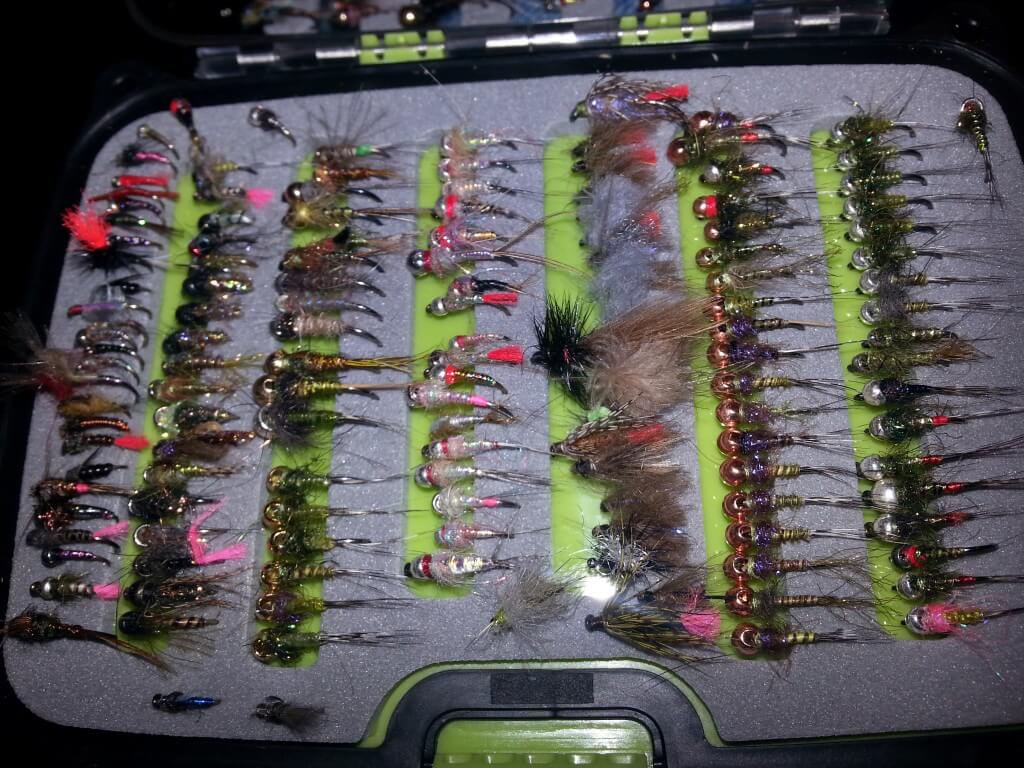Pheasant Tail Droppers
This is a quick post on the use of heavy PT nymphs for big waters. The fly pictured below is representative of the clinger mayflies (like Stenonema). It uses heavy lead wraps (mashed flat) right behind the tungsten bead (3.5 mm). The hook is a # 12 Mustad 3399. Partridge is used for the tail and the legs. Pheasant tail for the abdomen, prism dub mixed with a few hares ear is used for the thorax region. Peacock pulled over for the wing case. Very simple and fast tie and highly effective. pheasant tail droppers
The goal with the clingers is that you can add quite a bit more weight than average for such a small fly. The body profile shape is an important factor in determining sink rates in addition to weight. The fly in the pic weighs in at 9.4 grains which is great for a dropper or on the point depending on the conditions. This fly is best used on bright sunny days with clear waters. With these conditions I believe the natural colors perform better overall (hence the use of a copper bead that matches the insect). I use mylar, hot spots, etc.. more on overcast days or when the water has a stained color.
This fly is best used on bright sunny days with clear waters. With these conditions I believe the natural colors perform better overall (hence the use of a copper bead that matches the insect). I use mylar, hot spots, etc.. more on overcast days or when the water has a stained color. We have had many blue quills and baetis the past few weeks since the weather has warmed up.
The other benefit of using these heavy flies is when you want to fish a very small fly on or near the bottom. Use the PT dropper as you would normally add lead on the dropper. Use the tiny fly on the point for taking both flies near the bottom layer. This is often typical when fronts move through and fish are not active. Another trick for playing around with at the vise is to color-code your patterns (I use black, brown, gray, and olive for various weighted flies). For flies with hot spots tied in them, I use fluorescent colors. The main beads used for heavier flies include glass, brass, and tungsten weight. I add more copper or lead wire to many patterns. pheasant tail droppers
Color Coding
I find it easiest to put together at least a few dozen patterns at one time in the box with a color-coded thread. I use a scale that measures the average weight for specific patterns. Using the thread color system makes it easy to know which ones to use for matching the conditions. I learned about the thread color scheme from Joe Humphries (who was one of my big mentors when I was a kid). When you open up the nymph boxes it becomes much less of a guessing game how much a nymph weighs.
Another trick with these dropper flies is to use either a jig hook for having the fly ride upside down or add a clam shot to the top side of the hook shank. Jig hooks cause the flies to ride hook point up. I also believe the inverted hook aids in a higher percentage of hookups. Play around with rigging different combination’s for matching the conditions.
Find a balance between the flies when using the dry/dropper tactic. The dry fly, yarn, foam, thingamabobber, or air-lock must be sensitive for subtle strike detection. The slightest take can register when this balance is optimal. Will get up some pics here soon of various rigging techniques. -Enjoy, MB

